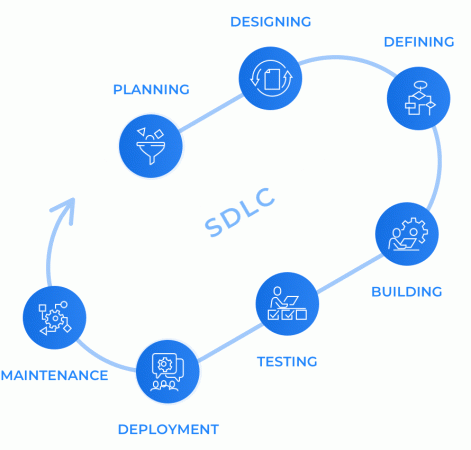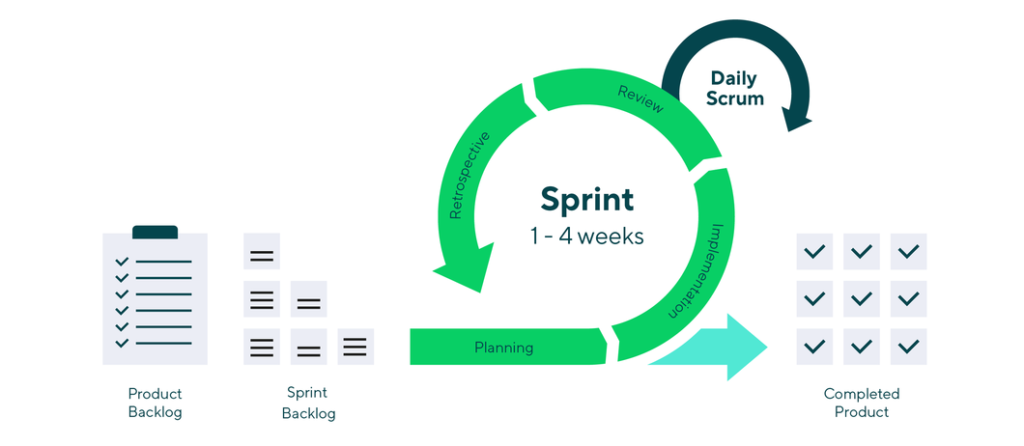

The software development process at Sukra Infotek, as with all great projects, starts with an idea. It takes planning, preparation, definition and management of software development phases and resource management to achieve the goals of every engagement. SDLC at Sukra is a mapped-out, regulated framework that typically follows the following universal phases to deliver high-quality software applications..

The planning phase is probably the most critical part of the software development life cycle, as it sets the project’s success potential. During this phase, project and product managers confirm the allocation of resources, plan capacity, and determine the schedule and cost of the project before then communicating the details.
This initial phase involves setting expectations, and it’s when team leaders assess the project’s terms. As well as setting the scope and purpose, planning also sets boundaries to prevent unplanned scope expansion or shifts away from its original objective.
Requirements analysis is also relevant at this stage, which is the process of collecting and analyzing feedback to influence which requirements to examine in the next phase. Input from stakeholders, customers (potential and current), and other subject matter experts is critical to building high-value software for your users.
The requirements analysis phase is an extension of the planning phase, but sometimes, these phases are combined. Feedback from stakeholders is synthesized and formed into functional requirements that engineers and designers can use to produce the necessary work. Requirements help align product development teams on the specific tasks they are assigned to do.
The design phase determines and defines the technical details of a project. For example, depending on the nature of the project, the design phase might include creating screen designs, prototypes, process diagrams, and system interfaces.
During this phase, designers also determine the architecture, programming language, platforms, and user interface designs. This phase effectively takes the product vision and specifies how that vision will come to life.
With the requirements defined and design documents completed, the development team should have everything they need to build the product. All work done in previous stages is leveraged during this phase to make the product a reality. Next, code writing takes place, which is then reviewed and shipped to a QA environment for testing.
The testing phase verifies that the software functionality meets the defined requirements and prevents major defects from being shipped to end-users in production. A combination of automated and manual testing takes place during this phase. The testing team typically runs many tests, including unit, integration, performance, and functional testing.
The development team receives bug reports from the testing team that informs them about defects to fix. In addition, to help leadership understand the testing phase results, such as the number of tests run and defects found, they, too, receive reports.
The application is made available to users in the production environment during this phase. The deployment process can be pretty complex depending on the application’s environment and architecture. This phase embodies the completion of work. In parallel with Deployment events, product teams partner with marketing and customer teams, get the message out to users, update them on changes, and announce the release of a new product or feature.
The deployment phase involves pushing the code to the production environment. After deploying the code, customers can start using the new or updated functionality. By this point, the customer-facing and marketing teams should have the information they need to help customers and announce the launch broadly.
Before release, many teams deploy the code to other environments, such as a sandbox, UAT, or other pre-production environments.
Sometimes referred to as the “monitoring” phase, this last part of the software development life cycle is ongoing. Once the software is built and fully operational, the product needs regular maintenance checks. In addition, some software applications might need upgrades, bug fixes, and improvements to be integrated into new environments or with new systems.
DevOps teams help ensure the product remains available and stable for all users after deployment. However, incidents happen where on-call team members must react quickly to fix issues that arise to minimize downtime. Maintaining the software is as important as building it because, in production, users rely on your product for its intended use.
The Agile methodology centered around incremental and iterative steps to completing projects. allows us to release reliable software fast and introduce changes easily. The development process consists of 1-4 week iterations resulting in an evolved version of software shipped each time. After each iteration, we get real user feedback that drives informed decisions on the next development steps.This approach prioritises quick delivery, adapting to change, and collaboration rather than top-down management and following a set plan


With an established DevOps culture at Sukra, we streamline software delivery and improve its
quality with the following DevOps best practices:
Infrastructure as Code (IaC):automating the creation of new infrastructures and
keeping
them consistent with each other to ensure smooth software deployment.
Continuous Integration / Continuous Delivery or Continuous Deployment
(CI/CD): automating integration and deployment of code changes.
Automated testing: automating regression, performance, and other types of testing
that
are continuously carried out within the CI/CD pipeline.
Application performance monitoring: configuring application performance monitoring
tools
to detect post-release bugs quick.
Sukra is a forward-thinking organization that specializes in cloud-native development, a cutting-edge approach to building and deploying applications. Our team is passionate about leveraging the full potential of cloud computing to create scalable, resilient, and agile software solutions. With a strong focus on microservices architecture, containerization, and kubernetes orchestration, we design applications that can adapt and thrive in the dynamic cloud environment. By embracing DevOps practices and CI/CD pipelines, we ensure seamless collaboration between development and operations, enabling faster delivery and continuous improvement of our clients’ applications. At the heart of our company’s ethos lies a commitment to empowering businesses with cloud-native capabilities, enabling them to stay ahead in today’s rapidly evolving digital landscape. Partner with us, and together, we will unlock the true potential of cloud-native development for your success.


Sukra is a technology-focused organization that firmly believes in the value of modular architecture in application development. Our modular architecture approach centers around building software systems as a composition of smaller, self-contained modules that can be easily developed, tested, and deployed independently. By adopting a modular architecture, we aim to achieve greater flexibility, reusability, and maintainability in our solutions.
Our team of skilled engineers is well-versed in the latest practices and technologies related to modular architecture, such as microservices, containerization, and serverless computing. We strive to ensure that our clients’ applications are designed to be adaptable, scalable, and future-proof, ready to meet the evolving demands of their businesses
For each stage of SDLC, we have well defined work habits, practices and policies aimed at ensuring the high quality of our deliverables. Sukra’s skilled and motivated task force who effectively put those into practice. Our quality management system comprise of defining clear project costs, time frames, and milestones, preparing risk mitigation plans and project-specific KPIs, following unified code rules, performing unit testing and code reviews, promoting feasible automation of development, testing, integration and deployment, and more.
At Sukra, we establish clear and measurable goals that are aligned with the overall objectives of the customer requirements. This helps to create a sense of direction and purpose for employees, and ensures that everyone is working towards the same targets. We minimize management efforts on the customer’s side while providing a high level of transparency over the development process and proactive risk management.
Our customers have constant access to our task-tracking systems, such as Jira, and a knowledge base where we document all project-related work.
We regularly measure project health with KPIs to ensure the project’s progress and adjust the development process if needed.
Sukra’s team helps enterprises introduce essential security practices and toolsets at every level of their digital ecosystems. Be it ensuring operational security by verifying the immunity of operational environments or ensuring infrastructure security by efficient network design or server configurations or ensuring application security through security testing, Sukra always ensures the safety of customer assets
To make outsourcing engagement transparent both for clients and developers, we leverage planning, reporting and change management tools. This approach allows you to control project timeline and budget. Our approach combines the best aspects of lean and scrum to foster on‑demand scalability and agility. We are ready to adapt development processes to your schedule and requirement shifts at any project stage, whilst keeping the cost of change down.
We adopt an agile software development approach which is all about choosing to act according to values and common-sense principles that deliver value in a way that’s sustainable for everyone involved. We focus on collaboration and meaningful interactions and fostering respect and trust to improve everyone’s life: including the customer, the end-user and the developers.

“The Agile Scrum methodology is a lightweight software development methodology that focuses on having small time-boxed sprints of new functionality that are incorporated into an integrated product baseline. Scrum places an emphasis on transparent customer interaction, feedback and adjustments rather than documentation and prediction. Instead of phases, Scrum projects are broken down into releases and sprints. At the end of each sprint you have a fully functioning system that could be released:”
Other methods emphasize building an entire product in one iteration from start to finish that does not facilitate stakeholder interactions to quickly modify the direction of development to meet changing priorities or requirements. This methodology provides several benefits for software development teams and ultimately to the clients and applications developed.
Since the requirements (consisting of features, user stories and other backlog items) are deliberately kept high-level at the start, you have the flexibility to adapt the requirements from feedback from the customer and end users ‘on the fly’. This comes from the ability to redefine and replan after each release and sprint, giving the team plenty of room to respond to changes.
One of the challenges of software development for customers is that they cannot often appreciate the functionality of a system until they see it. By delivering working functionality in small increments, customers can see what they are getting earlier in the process and be confident that it is what they actually need or expect.
A study found that the majority of features delivered in traditional waterfall projects were never used or needed by customers, due to scope creep and feature bloat. With Scrum, you are ruthlessly pruning the release backlog after each sprint so these unnecessary features (and their associated costs) are quickly weeded out. The short-time boxes reduce the likelihood of risks materializing during the sprint and thus address increment delivery.
With engineering approaches such as continuous exploration, continuous integration, continuous delivery, test-driven development, DevOps, and relentless test automation, Scrum yields much higher-quality code, products and process. All of these benefit the final product that you deliver to stakeholders, which is one of the major reasons why scrum is the most widely-used methodology when it comes to software development.
Scrum allows integrated teams of developers, designers, testers, and business / functional experts to all work together rather than working in individual ‘silos’. This cross-discipline collaboration fosters creativity and innovation, as well as more out-of-the-box solutions to problems that pop up.
Scrum lets team members from a variety of disciplines harness their different skills in a cross-cutting product development ethos. This ensures that the finished product is optimized by and uses the best skills in the organization, not just what’s written on someone’s job title.
With the flexibility to adjust scope and still deliver results, the problem of delivering a fixed scope, fixed-schedule project with a team goes away. Instead of long nights frantically replanning and retesting functionality, the team has a sustainable operating pace that makes employees proud of their work and not fighting to deliver against impossible deadlines.
 Helpdesk
Helpdesk

Loading...